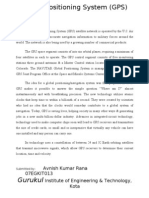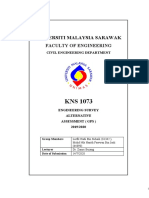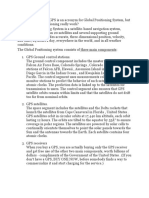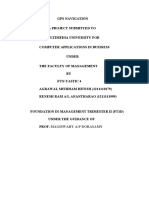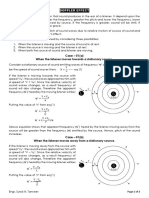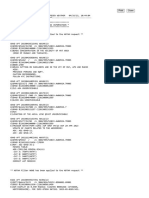GPS Systems
In the modern world, we take for granted the ability to pinpoint our exact location with
incredible accuracy. This seemingly effortless feat is made possible by a complex system known
as the Global Positioning System, or GPS. GPS is essentially a network of 31 satellites orbiting
the Earth, constantly transmitting radio signals. These signals are received by GPS receivers,
typically found in our smartphones, cars, and other devices. By analyzing the time, it takes for
these signals to reach the receiver, the device can calculate its precise location, altitude, and even
speed. This intricate system, born out of military research, has revolutionized navigation,
mapping, and countless other aspects of our lives.
The Global Positioning System (GPS) has a fascinating history rooted in the Cold War. The
origins of GPS can be traced back to the 1960s when the US military began experimenting with
satellite navigation systems to track submarines carrying nuclear missiles. The 1970s saw the
development of the Navstar system, which eventually became GPS. The first Navstar satellite
was launched in February 1978, and by the end of the year, three more were in orbit. The US
military continued to develop and refine the system, using it for military operations around the
globe.
In 1983, following the tragic Korean Airlines disaster, President Ronald Reagan announced that
GPS would be made available for civilian use. This decision was driven by the recognition that
GPS could significantly improve navigation and safety for commercial airlines. However, the
military initially maintained control over the system, limiting its accuracy for civilian users.
In 1996, President Bill Clinton declared GPS a national asset and made it fully available for
civilian use. This decision opened the door for the widespread adoption of GPS technology in
various industries, including transportation, mapping, and even personal devices. Today, GPS is
an indispensable tool for navigation, location tracking, and countless other applications.
GPS, or the Global Positioning System, works by using a network of 30+ satellites orbiting
Earth. These satellites constantly transmit radio signals that contain information about their
location and the precise time. A GPS receiver, like the one in your smartphone or car, picks up
these signals and uses them to determine its own location.
The core principle behind GPS is trilateration, which is a method of determining a location based
on the distances to three known points. In the case of GPS, the three known points are the
satellites. The receiver measures the time it takes for the signals from each satellite to reach it.
Since the speed of light is constant, the receiver can calculate the distance to each satellite.
Once the receiver has determined its distances to three satellites, it can use trilateration to
calculate its own position. This position is expressed in terms of latitude, longitude, and altitude.
Time synchronization is crucial for GPS to work accurately. The satellites are equipped with
atomic clocks that are incredibly precise. These clocks are synchronized with each other and with
the ground stations that control the GPS system. The receiver uses the time information from the
satellites to calculate the distances to them. If the receiver's clock is not synchronized with the
�satellites' clocks, the calculated distances will be inaccurate, and the receiver's position will be
off.
In addition to trilateration and time synchronization, GPS receivers also use a process called
signal reception to pick up the signals from the satellites. The receiver's antenna is designed to
receive the radio signals from the satellites. The signals are then processed by the receiver's
internal circuitry to extract the information about the satellites' positions and the time. The
quality of the GPS signal reception can be affected by factors such as atmospheric conditions,
obstructions, and the receiver's location.
GPS technology has a wide range of applications, impacting various aspects of our lives. Here
are some of the most prominent applications:
Navigation: GPS is the backbone of modern navigation systems, guiding us through roads,
oceans, and even the skies. It's used in cars, boats, airplanes, and even smartphones, allowing us
to find our way around unfamiliar places.
Mapping: GPS plays a crucial role in creating accurate maps and geographic information
systems (GIS). By collecting location data, GPS enables the development of detailed maps that
are used for various purposes, including urban planning, environmental monitoring, and disaster
response.
Surveying: GPS is used in surveying to determine precise locations and elevations of points on
the Earth's surface. This information is essential for construction projects, land management, and
infrastructure development.
Timing: GPS satellites are equipped with highly accurate atomic clocks, making them valuable
for time synchronization. This precise timing is used in various applications, including financial
transactions, telecommunications, and scientific research.
Tracking: GPS is used to track the movement of vehicles, ships, and even people. This
information is used for fleet management, asset tracking, and personal safety.
Agriculture: GPS is used in agriculture to guide tractors and other farm equipment, ensuring
precise planting and fertilization. It also helps farmers monitor crop health and optimize
irrigation.
Emergency Response: GPS is used by emergency responders to locate victims and coordinate
rescue efforts. It's also used to track the movement of emergency vehicles and ensure their
safety.
Military Applications: GPS is a critical technology for military operations, providing navigation,
targeting, and communication capabilities. It's used by soldiers, aircraft, and missiles to ensure
accurate positioning and coordination.
GPS technology offers a wide range of benefits across various fields, including improved safety,
efficiency, and convenience. For example, GPS tracking systems can alert management to
unauthorized use of vehicles, reducing fuel costs and improving fleet efficiency. GPS also plays
�a crucial role in improving safety by preventing train crashes and exceeding speed limits.
Additionally, GPS has generated $1.4 trillion in economic benefits since its release for civilian
and commercial use in the 1980s.
GPS technology is a powerful tool, but it does have some limitations and challenges. Some of the
most common challenges include signal interference, accuracy limitations, and privacy concerns.
For example, dense foliage and tall buildings can block or weaken GPS signals, leading to a loss
of accuracy or complete signal loss. Additionally, older or cheap GPS tracking devices can
contribute to inaccurate data. Finally, privacy concerns arise when GPS data is used to track
individuals without their consent.
The future of GPS technology is bright, with exciting advancements and applications on the
horizon. One of the most promising areas is the integration of GPS with artificial intelligence
(AI). AI algorithms can analyze vast amounts of data from GPS tracking systems, learn patterns,
and make intelligent predictions. This can lead to smarter and more intuitive navigation
experiences, as well as optimized routes that take into account real-time traffic conditions,
weather patterns, and even driver behavior. Another exciting development is the integration of
GPS with the Internet of Things (IoT). This combination allows for the tracking and monitoring
of a wide range of objects and devices, from vehicles to packages to even individual people. This
has the potential to revolutionize industries such as logistics, agriculture, and healthcare. For
example, GPS-enabled IoT devices can be used to track the movement of goods in supply chains,
monitor the health of crops in fields, and even track the location of patients in hospitals. The
future of GPS technology is full of possibilities, and it is likely to play an increasingly important
role in our lives in the years to come.
GPS technology has revolutionized the way we navigate, map, and interact with the world
around us. Its origins in the US military led to its eventual release for civilian use, transforming
various industries and aspects of our daily lives. The core principles of triangulation, signal
reception, and time synchronization enable accurate location determination, offering a wide
range of applications from navigation and mapping to surveying, timing, and more. GPS
technology has brought numerous benefits, including improved safety, efficiency, and
convenience. However, it also faces challenges such as signal interference, accuracy limitations,
and privacy concerns. Despite these challenges, the future of GPS is bright, with exciting
advancements in integration with AI and the IoT promising even more innovative applications.
GPS technology has become an indispensable tool in modern society, enabling us to navigate,
track, and manage our world with greater precision and efficiency.
Angela Angeleska

























